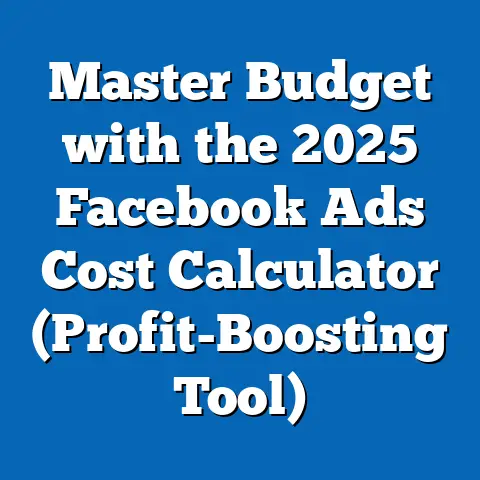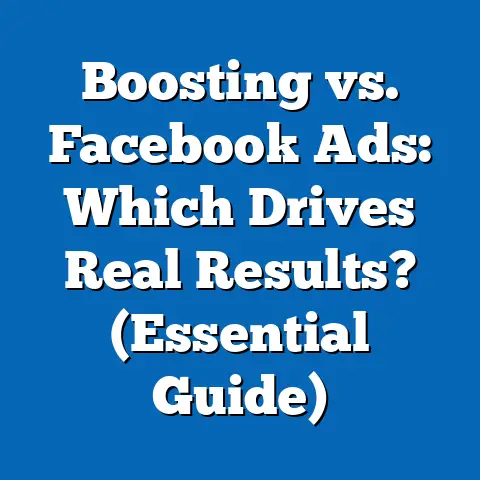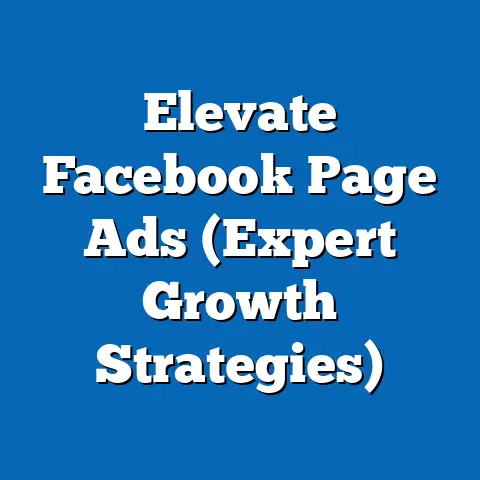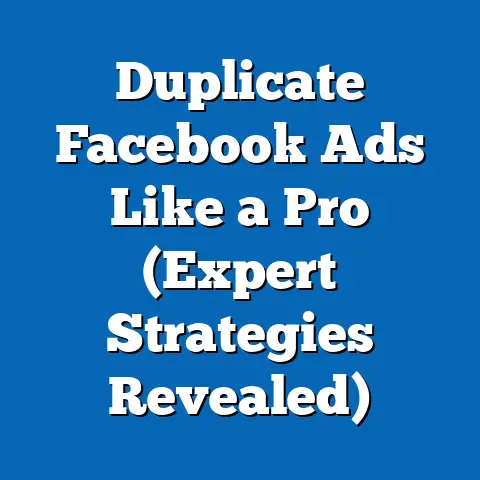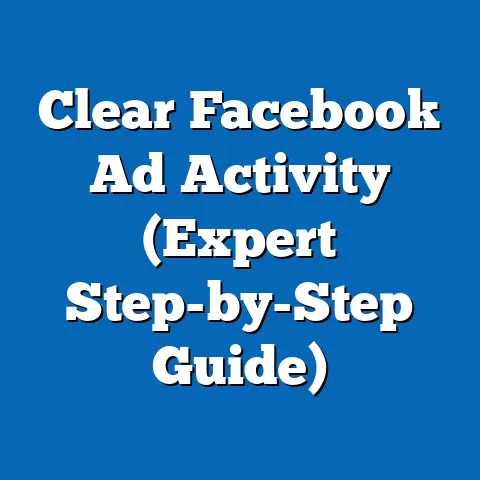Facebook Ads vs Google Ads for Ecommerce (Strategic Insights)
In the ever-evolving world of e-commerce, where trends shift faster than you can say “add to cart,” one thing remains constant: the critical need for effective advertising. It’s not just about having a great product anymore; it’s about making sure the right people see it at the right time. And that’s where digital advertising steps in, a realm dominated by two giants: Facebook Ads and Google Ads. I’ve spent countless hours navigating the intricacies of both platforms, witnessing firsthand their power to transform businesses. But I’ve also seen companies waste fortunes by not understanding their unique strengths and weaknesses. So, which one is the right choice for your e-commerce venture? Let’s dive into a strategic comparison, exploring the nuances that can make or break your online advertising success.
Understanding the Platforms: A Tale of Two Titans
To truly grasp the difference between Facebook and Google Ads, you need to understand their fundamental nature. Think of them as two distinct ecosystems, each thriving on a different kind of user behavior.
Facebook Ads: The Social Butterfly
Facebook Ads, now under the Meta umbrella, thrives on user demographics and engagement. It’s a place where people come to connect, share, and discover. With billions of active users, Facebook provides a massive audience pool, ripe for targeting. The platform’s visual nature is a huge asset for e-commerce brands. It allows you to tell your brand’s story through captivating images and videos, creating an emotional connection with potential customers.
I’ve found that the key to success on Facebook is understanding its format diversity. Carousel ads let you showcase multiple products in a single ad, while video ads grab attention and tell a compelling story. Collection ads offer an immersive shopping experience, allowing users to browse and purchase products directly from the ad. For instance, I once helped a small jewelry brand use carousel ads to highlight different pieces from their collection. The visual format, combined with targeted messaging, led to a significant increase in website traffic and sales.
Google Ads: The Intent-Driven Hunter
Google Ads, on the other hand, operates on a different principle: search intent. Users come to Google with a specific need or question, actively seeking information or products. This makes Google Ads a powerful tool for capturing intent-based traffic. When someone searches for “best running shoes,” they’re likely in the market for a new pair. Google Ads allows you to put your product right in front of them at that crucial moment.
The platform offers a variety of ad types, each designed for a specific purpose. Search ads are text-based ads that appear on Google’s search results page. Shopping ads showcase your products directly, including images, prices, and store names. Display ads appear on websites across the Google Display Network, allowing you to reach a broader audience. I remember working with an online bookstore that used Google Shopping ads to promote their new arrivals. By targeting relevant keywords and optimizing their product listings, they saw a dramatic increase in sales and a higher return on ad spend.
Targeting Capabilities: Precision vs. Broad Reach
One of the most significant differences between Facebook and Google Ads lies in their targeting capabilities. While both platforms offer powerful tools for reaching the right audience, they approach targeting in fundamentally different ways.
Facebook Ads: The Art of Personalization
Facebook Ads excels at demographic, interest-based, and behavioral targeting. You can target users based on their age, gender, location, education, interests, and even their online behavior. This allows e-commerce brands to create highly personalized ad experiences that resonate with their target audience.
I’ve often used Facebook’s detailed targeting options to create lookalike audiences. By uploading a list of existing customers, Facebook can identify users who share similar characteristics and behaviors. This is a powerful way to expand your reach and find new customers who are likely to be interested in your products. For example, I worked with a subscription box company that used lookalike audiences to target users who were similar to their existing subscribers. This strategy resulted in a significant increase in subscriber acquisition and a lower cost per acquisition.
Google Ads: The Power of Intent
Google Ads focuses on keyword targeting and audience targeting through remarketing lists, customer match, and in-market audiences. Keyword targeting allows you to show your ads to users who are searching for specific keywords related to your products. Remarketing lists allow you to target users who have previously interacted with your website. Customer match allows you to upload a list of customer email addresses and target those users with personalized ads. In-market audiences allow you to target users who are actively researching or considering purchasing products in a specific category.
I’ve found that the key to success with Google Ads is understanding the different stages of the buying funnel. Users who are searching for “best running shoes” are at a different stage than users who are searching for “where to buy running shoes near me.” By targeting users at different stages of the funnel with relevant ads, you can increase your chances of converting them into customers. For instance, I helped an online clothing store use remarketing lists to target users who had abandoned their shopping carts. By showing them personalized ads with a discount code, they were able to recover a significant portion of those abandoned carts.
Cost and Budgeting: Navigating the Financial Landscape
Understanding the cost structures of Facebook and Google Ads is crucial for effective budget management. Both platforms operate on a bidding system, where advertisers bid for ad placements. The actual cost you pay depends on a variety of factors, including your target audience, the quality of your ads, and the competition from other advertisers.
Facebook Ads: The Auction House
Facebook Ads primarily uses two bidding models: cost-per-click (CPC) and cost-per-impression (CPM). CPC means you pay each time someone clicks on your ad, while CPM means you pay for every 1,000 impressions your ad receives. I’ve found that CPC is generally a better option for e-commerce brands that are focused on driving traffic and conversions, while CPM can be effective for building brand awareness.
One of the biggest challenges with Facebook Ads is managing your budget effectively. The platform’s algorithm can be unpredictable, and it’s easy to overspend if you’re not careful. I recommend setting daily or lifetime budgets to control your spending and monitoring your performance closely. It’s also important to test different bidding strategies and targeting options to find what works best for your business.
Google Ads: The Strategic Game
Google Ads also uses CPC and CPM bidding models, but it also offers other options, such as cost-per-acquisition (CPA) bidding. CPA bidding allows you to pay only when someone takes a specific action, such as making a purchase or filling out a form. This can be a great option for e-commerce brands that are focused on driving conversions.
I’ve found that the key to success with Google Ads is optimizing your quality score. Your quality score is a measure of the relevance and quality of your ads. A higher quality score can lead to lower costs and better ad placements. To improve your quality score, you need to focus on creating relevant ads, using targeted keywords, and providing a positive user experience.
Performance Metrics and Analytics: Measuring What Matters
Measuring the performance of your Facebook and Google Ads campaigns is essential for optimizing your results and maximizing your ROI. Both platforms offer a wealth of data and analytics, allowing you to track key performance indicators (KPIs) and identify areas for improvement.
Facebook Ads: Engagement and Conversions
On Facebook Ads, I focus heavily on engagement rates, conversions, and reach. Engagement rates measure how users are interacting with your ads, including likes, comments, and shares. Conversions track the number of users who take a desired action, such as making a purchase or signing up for a newsletter. Reach measures the number of unique users who have seen your ads.
I’ve found that A/B testing is crucial for optimizing your Facebook Ads campaigns. By testing different ad creatives, targeting options, and bidding strategies, you can identify what resonates best with your audience and improve your performance. For instance, I once helped an online clothing store A/B test different ad creatives, using one image with a model wearing the clothes and another image with the clothes displayed on a white background. The image with the model significantly outperformed the other image, leading to a higher click-through rate and more sales.
Google Ads: Clicks, Conversions, and Quality
On Google Ads, I pay close attention to click-through rates, conversion tracking, and quality scores. Click-through rates measure the percentage of users who click on your ads after seeing them. Conversion tracking allows you to track the number of users who take a desired action after clicking on your ads. Quality scores measure the relevance and quality of your ads.
I’ve found that using Google Analytics in conjunction with Google Ads is essential for understanding the customer journey. Google Analytics allows you to track user behavior on your website, providing valuable insights into how users are interacting with your products and services. By analyzing this data, you can identify areas for improvement and optimize your campaigns for better results.
Case Studies and Success Stories: Learning from the Best
To illustrate the power of Facebook and Google Ads, let’s take a look at a few case studies and success stories:
-
Example 1: A Local Bakery Using Facebook Ads
- Business Goal: Increase brand awareness and drive foot traffic to a local bakery.
- Strategy: Targeted Facebook Ads to users within a 5-mile radius, showcasing visually appealing images of their pastries and cakes.
- Outcome: Significant increase in foot traffic and a 20% rise in sales within the first month.
-
Example 2: An Online Electronics Store Using Google Ads
-
Business Goal: Drive online sales of high-end headphones.
- Strategy: Utilized Google Shopping Ads with detailed product descriptions and competitive pricing. Optimized keyword targeting to reach users searching for specific headphone models.
- Outcome: Achieved a 30% increase in online sales and a positive return on ad spend.
Example 1: A Local Bakery Using Facebook Ads
- Business Goal: Increase brand awareness and drive foot traffic to a local bakery.
- Strategy: Targeted Facebook Ads to users within a 5-mile radius, showcasing visually appealing images of their pastries and cakes.
- Outcome: Significant increase in foot traffic and a 20% rise in sales within the first month.
-
Example 2: An Online Electronics Store Using Google Ads
-
Business Goal: Drive online sales of high-end headphones.
- Strategy: Utilized Google Shopping Ads with detailed product descriptions and competitive pricing. Optimized keyword targeting to reach users searching for specific headphone models.
- Outcome: Achieved a 30% increase in online sales and a positive return on ad spend.
Example 2: An Online Electronics Store Using Google Ads
Business Goal: Drive online sales of high-end headphones.
These examples highlight the importance of tailoring your advertising strategy to your specific business goals and target audience.
Conclusion: A Harmonious Blend
In conclusion, both Facebook Ads and Google Ads offer unique advantages for e-commerce businesses. Facebook Ads excels at building brand awareness and driving engagement through personalized ad experiences, while Google Ads excels at capturing intent-based traffic and driving conversions through targeted keyword advertising. The best approach often involves a harmonious blend of both platforms, leveraging their strengths to achieve your overall marketing goals. Consider your specific business goals, target audience, and product offerings when choosing between the two platforms. By understanding their nuances and optimizing your campaigns accordingly, you can unlock the full potential of digital advertising and drive sustainable growth for your e-commerce venture.

